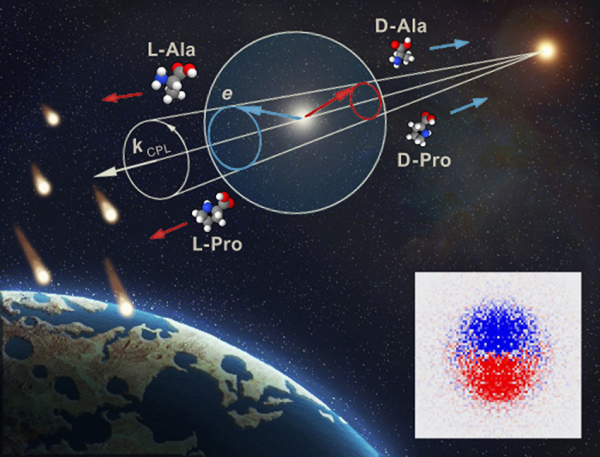Chiral molecules exist in two forms, called enantiomers, which cannot be superimposed but are mirror images one of the other. Amino acids, the chiral elementary building blocks of proteins, only exist as their left form in the biosphere. How did this selection process happen? Researchers from DESIRS beamline, in collaboration with a research team from the University of Nottingham, have confirmed a scenario for the amino acid proline that was proposed a few years ago for another amino acid, alanine. Gaseous amino acids would interact with ultraviolet light, itself ‘chiral’, in a manner capable of inducing an excess of the left or right enantiomer in a given direction in space. The study also shows that this phenomenon would be valid over a wide range of temperatures, i.e. compatible with the interstellar origin of these elementary building blocks of life. This work has just been published in the journal Communications Chemistry (Nature Group).
Since its discovery by Pasteur more than 150 years ago, the origin of the biomolecular asymmetry, or homochirality of life (for example, the fact that amino acids, which constitute the chiral elementary building blocks of proteins, are all of the left-hand type) remains an unresolved and troubling mystery, probably linked to the origin of life itself. This symmetry breakdown, and its possible deterministic nature resulting from chemical or physical laws, has been at the centre of a wide range of scenarios. Many amino acids have been found in carbonaceous meteorites with enantiomeric excesses (E.E.), i.e. a left/right ratio different from 50/50, and an isotopic composition indicating an extra-terrestrial origin. If an interstellar origin of the elementary building blocks of life is assumed, then an asymmetric bias applied to this interstellar material before its arrival of on our planet must be identified, inducing a significant E.E. which was probably a necessary condition for the development of life on Earth.
Among the deterministic scenarios are those based on asymmetric processes induced by circularly polarised light (CPL), i.e. photons, themselves chiral, which are likely to interact differently (according to their chirality) with a left or right enantiomer. This process, known as chiral recognition, might be compared to a right shoe that fits a right foot. Astronomical sources of CPL have indeed been reported, particularly in star forming regions such as those in which our sun was born. Several photochemical asymmetric processes have been proposed and simulated on solid state interstellar ice analogues with CPL in the UV range, producing a significant E.E. of the order of several %.
In the recently published article in Communications Chemistry, researchers have confirmed an alternative asymmetric photophysical process that acts on gaseous amino acids: following ionisation (ejecting of an electron) by the UV chiral light, the left and right ionic enantiomers undergo a recoil motion in opposite directions versus the axis of the incident light, caused by an effect referred to as Photoelectron Circular Dichroism (PECD).
Experiments have been conducted on the DESIRS beamline at synchrotron SOLEIL, using ‘chiral’ photons in the far UV range (wavelengths close to those of X-rays) to ionise proline, one of the 22 proteic amino acids. With UV light corresponding to the most intense radiation encountered in the interstellar environment (wavelength = 121 nm), an asymmetry between the two enantiomers equivalent to a maximum E.E. of up to 12% has been measured. That is, if one follows the UV light propagation direction, the concentration of left ionic enantiomer is 6% higher (and therefore that of the right ionic enantiomer is 6% lower...) in an area of space at the front of the cloud containing an initial 50/50 mixture of the 2 forms of neutral amino acid – the proportions being reversed at the rear of the same cloud. One of the major points here is that this asymmetry changes in the same sense as that of alanine (see figure) and serine, two others of the 22 amino acids found in living organisms.
Finally, experimental measurements at three temperatures, combined with theoretical simulations of asymmetries, allow the results to be extrapolated over a wide range of temperatures (from a few degrees K to a few hundred degrees K) as possibly encountered in interstellar space and thus validating the scenario whatever the astrophysical thermal conditions for the three amino acids studied to date.

An artist's view showing how asymmetric ionisation of gaseous alanine and proline, inducing a forward/backward asymmetric angular distribution of the ejected electron, produces an asymmetric flux of ionised enantiomers corresponding to an enantiomeric excess along a given line of sight.
PECD thus appears to be an asymmetric process capable of producing a gas phase cloud of enantio-enriched ions of a given chirality, which separates from its counterpart and is then captured, neutralised and incorporated in comets and meteorites seeding the Earth with exogenous organic matter exhibiting an initial E.E. It is thus possible that this process, combined with others, could have triggered the appearance of biomolecular asymmetry and thus contributed to the appearance of life on Earth.
